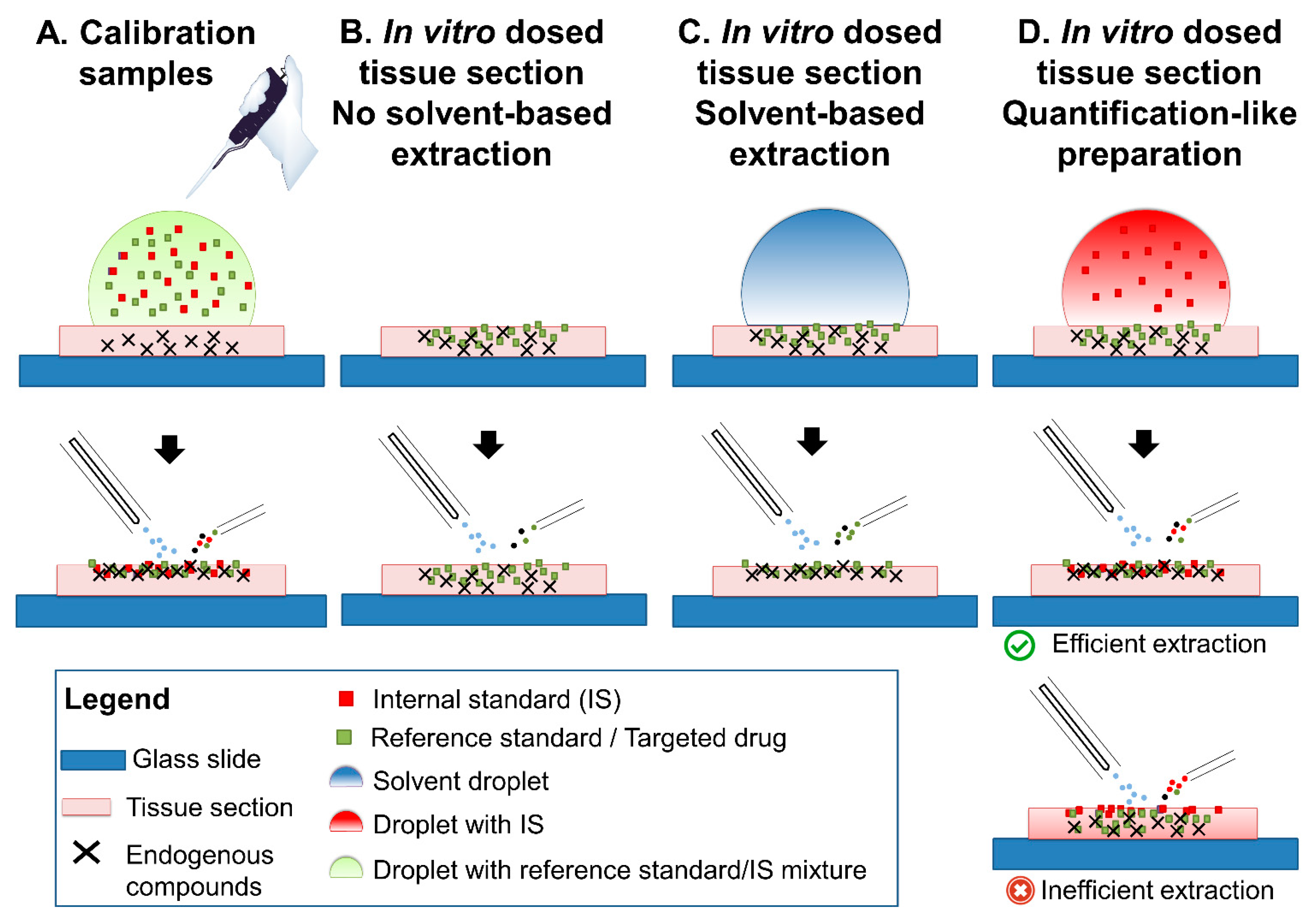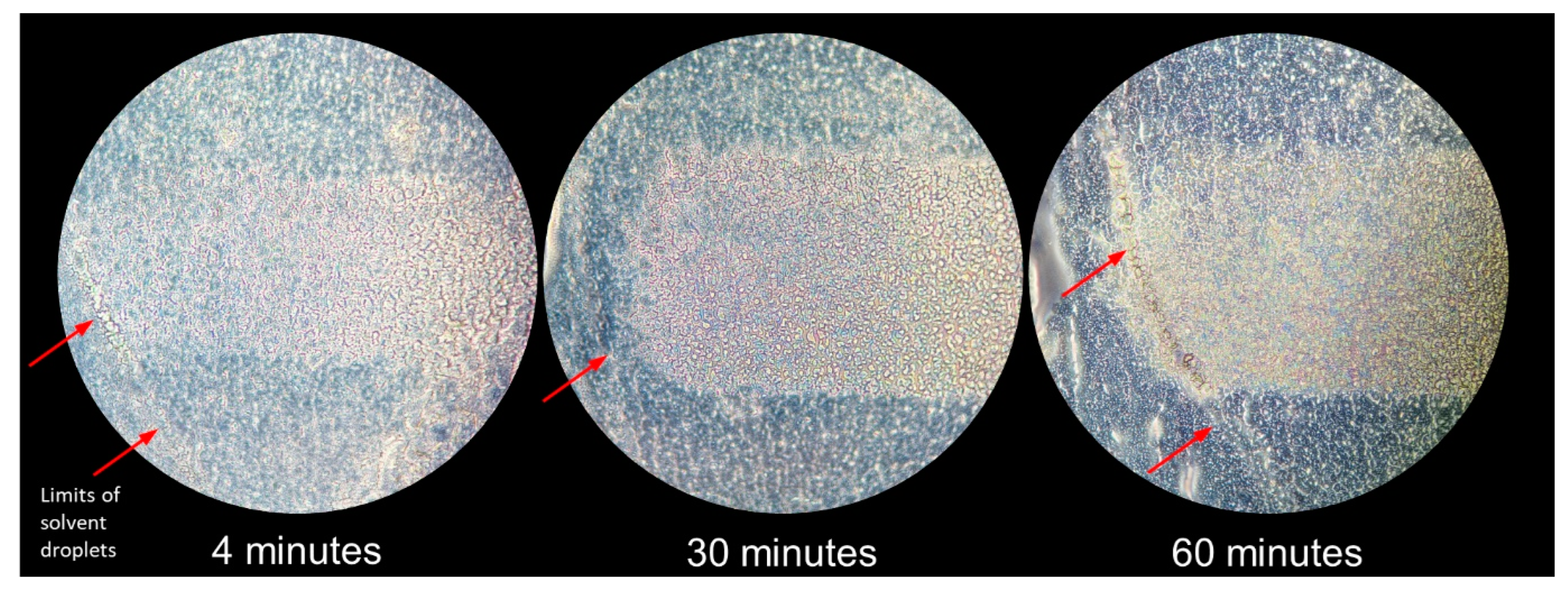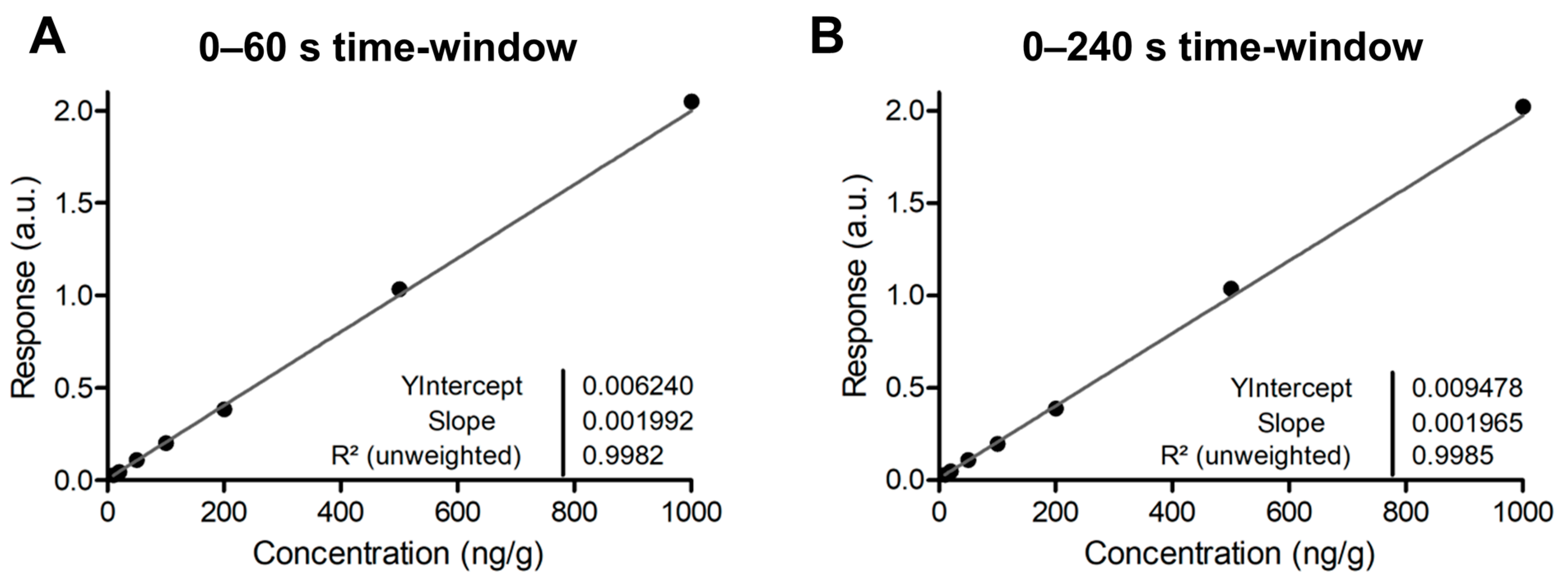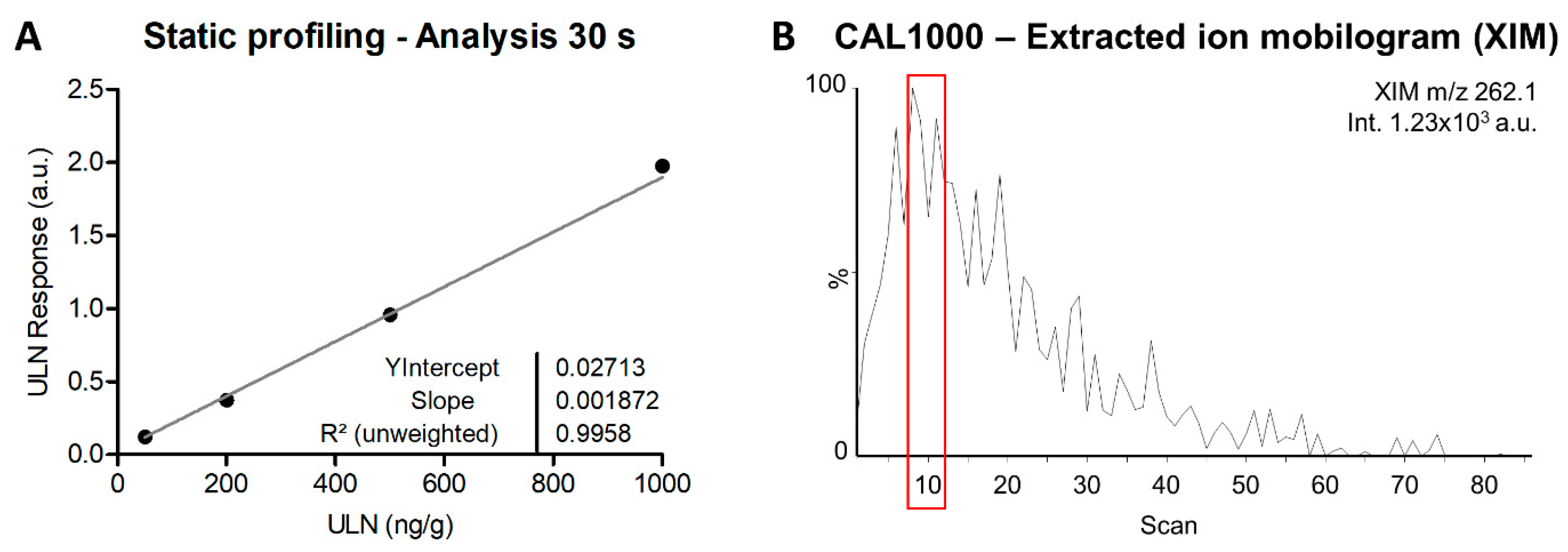Desorption Kinetics Evaluation for the Development of Validated Desorption Electrospray Ionization-Mass Spectrometric Assays for Drug Quantification in Tissue Sections
Abstract
1. Introduction
2. Results
2.1. Tissue Morphology Kinetics
2.2. Desorption Kinetics
2.3. Optimal Analysis Time Determination
2.4. Evaluation of Extraction Processes from Dosed Tissues
2.4.1. Differential Extraction Effects from Droplet Deposition and DESI Solvent Spray
2.4.2. Evaluation of Response Kinetics in In Vitro-Dosed Tissues
2.5. Feasibility and Parameter Predictions for DESI-Imaging
3. Discussion
4. Material and Methods
4.1. Chemicals
4.2. Solutions Preparation
4.3. Animal Dissection
4.4. In Vitro Dosed Tissue Preparation
4.5. Tissue Sectioning
4.6. Solution Deposition on Tissues
4.7. Mass Spectrometric Analyses
4.8. Data Processing
4.9. Analytical Quality Parameters
- (i)
- Calibration curve: There should be a minimum of six accepted non-zero concentration levels, and linearity should be proven over the full calibration range using the same regression model. As a in-study rule, linear regression with 1/x2 weighing was always applied and a valid determination factor r2 should be >0.985.
- (ii)
- Accuracy: Each calibration sample was accepted only with an accuracy of ±15% bias, except at the lower limit of quantification (LLOQ), where an accuracy of ±20% bias should be achieved.
- (iii)
- Precision: Each calibration level was accepted if the precision between replicates was <15% CV or <20% CV at the LLOQ, and if at least 50% of replicates were accepted.
- (iv)
- Total accepted replicates: These should be at least 75% of measured calibration standard replicates.
5. Conclusions
Author Contributions
Funding
Institutional Review Board Statement
Informed Consent Statement
Data Availability Statement
Acknowledgments
Conflicts of Interest
References
- Longuespee, R.; Theile, D.; Fresnais, M.; Burhenne, J.; Weiss, J.; Haefeli, W.E. Approaching sites of action of drugs in clinical pharmacology: New analytical options and their challenges. Br. J. Clin. Pharmacol. 2021, 87, 858–874. [Google Scholar] [CrossRef]
- Liu, X.; Ide, J.L.; Norton, I.; Marchionni, M.A.; Ebling, M.C.; Wang, L.Y.; Davis, E.; Sauvageot, C.M.; Kesari, S.; Kellersberger, K.A.; et al. Molecular imaging of drug transit through the blood-brain barrier with MALDI mass spectrometry imaging. Sci. Rep. 2013, 3, 2859. [Google Scholar] [CrossRef] [PubMed]
- Lee, R.F.S.; Theiner, S.; Meibom, A.; Koellensperger, G.; Keppler, B.K.; Dyson, P.J. Application of imaging mass spectrometry approaches to facilitate metal-based anticancer drug research. Met. Integr. Biometal Sci. 2017, 9, 365–381. [Google Scholar] [CrossRef] [PubMed]
- Bodzon-Kulakowska, A.; Suder, P. Imaging mass spectrometry: Instrumentation, applications, and combination with other visualization techniques. Mass Spectrom. Rev. 2016, 35, 147–169. [Google Scholar] [CrossRef] [PubMed]
- Davoli, E.; Zucchetti, M.; Matteo, C.; Ubezio, P.; D’Incalci, M.; Morosi, L. The Space Dimension at the Micro Level: Mass Spectrometry Imaging of Drugs in Tissues. Mass Spectrom. Rev. 2021, 40, 201–214. [Google Scholar] [CrossRef]
- Ogrinc Potocnik, N.; Fisher, G.L.; Prop, A.; Heeren, R.M.A. Sequencing and Identification of Endogenous Neuropeptides with Matrix-Enhanced Secondary Ion Mass Spectrometry Tandem Mass Spectrometry. Anal. Chem. 2017, 89, 8223–8227. [Google Scholar] [CrossRef]
- Van Malderen, S.J.M.; Van Acker, T.; Vanhaecke, F. Sub-micrometer Nanosecond LA-ICP-MS Imaging at Pixel Acquisition Rates above 250 Hz via a Low-Dispersion Setup. Anal. Chem. 2020, 92, 5756–5764. [Google Scholar] [CrossRef]
- Becker, J.S.; Zoriy, M.; Matusch, A.; Wu, B.; Salber, D.; Palm, C.; Becker, J.S. Bioimaging of metals by laser ablation inductively coupled plasma mass spectrometry (LA-ICP-MS). Mass Spectrom. Rev. 2010, 29, 156–175. [Google Scholar] [CrossRef]
- Pisonero, J.; Koch, J.; Walle, M.; Hartung, W.; Spencer, N.D.; Gunther, D. Capabilities of femtosecond laser ablation inductively coupled plasma mass spectrometry for depth profiling of thin metal coatings. Anal. Chem. 2007, 79, 2325–2333. [Google Scholar] [CrossRef]
- Schulz, S.; Becker, M.; Groseclose, M.R.; Schadt, S.; Hopf, C. Advanced MALDI mass spectrometry imaging in pharmaceutical research and drug development. Curr. Opin. Biotechnol. 2019, 55, 51–59. [Google Scholar] [CrossRef]
- Barre, F.P.Y.; Paine, M.R.L.; Flinders, B.; Trevitt, A.J.; Kelly, P.D.; Ait-Belkacem, R.; Garcia, J.P.; Creemers, L.B.; Stauber, J.; Vreeken, R.J.; et al. Enhanced Sensitivity Using MALDI Imaging Coupled with Laser Postionization (MALDI-2) for Pharmaceutical Research. Anal. Chem. 2019, 91, 10840–10848. [Google Scholar] [CrossRef] [PubMed]
- Shelley, J.T.; Badal, S.P.; Engelhard, C.; Hayen, H. Ambient desorption/ionization mass spectrometry: Evolution from rapid qualitative screening to accurate quantification tool. Anal. Bioanal. Chem. 2018, 410, 4061–4076. [Google Scholar] [CrossRef]
- Fresnais, M.; Burhenne, J.; Haefeli, W.E.; Longuespee, R. Desorption/Ionization-MS Methods for Drug Quantification in Biological Matrices and Their Validation Following Regulatory Guidance. Anal. Chem. 2021, 93, 7152–7163. [Google Scholar] [CrossRef] [PubMed]
- Kallback, P.; Vallianatou, T.; Nilsson, A.; Shariatgorji, R.; Schintu, N.; Pereira, M.; Barre, F.; Wadensten, H.; Svenningsson, P.; Andren, P.E. Cross-validated Matrix-Assisted Laser Desorption/Ionization Mass Spectrometry Imaging Quantitation Protocol for a Pharmaceutical Drug and Its Drug-Target Effects in the Brain Using Time-of-Flight and Fourier Transform Ion Cyclotron Resonance Analyzers. Anal. Chem. 2020, 92, 14676–14684. [Google Scholar] [CrossRef]
- Fresnais, M.; Muck, A.; Majewsky, M.; Statz, B.; Krausert, S.; Benzel, J.; Castel, D.; Le Dret, L.; Pfister, S.; Haefeli, W.E.; et al. Rapid and Sensitive Drug Quantification in Tissue Sections Using Matrix Assisted Laser Desorption Ionization-Ion Mobility-Mass Spectrometry Profiling. J. Am. Soc. Mass Spectrom. 2020, 31, 742–751. [Google Scholar] [CrossRef] [PubMed]
- Fresnais, M.; Liang, S.; Breitkopf, M.; Lindner, J.R.; Claude, E.; Pringle, S.; Levkin, P.A.; Demir, K.; Benzel, J.; Sundheimer, J.; et al. Analytical Performance Evaluation of New DESI Enhancements for Targeted Drug Quantification in Tissue Sections. Pharmaceuticals 2022, 15, 694. [Google Scholar] [CrossRef] [PubMed]
- Fresnais, M.; Haefeli, W.E.; Burhenne, J.; Longuespee, R. Rapid drug detection in whole blood droplets using a desorption electrospray ionization static profiling approach—A proof-of-concept. Rapid Commun. Mass Spectrom. RCM 2020, 34, e8614. [Google Scholar] [CrossRef]
- Fresnais, M.; Haefeli, W.E.; Burhenne, J.; Longuespee, R. Advances in Clinical Pharmacology: Rapid Detection of Small Molecules in Solid Samples at Atmospheric Pressure Using Desorption Electrospray Ionization. Omics J. Integr. Biol. 2020, 24, 53–54. [Google Scholar] [CrossRef]
- ICH. International Council for Harmonisation of Technical Requirements for Pharmaceuticals for Human Use—ICH Guideline M10 on Bioanalytical Method Validation and Study Sample Analysis; ICH: Geneve, Switzerland, 2022. [Google Scholar]
- Sigaud, R.; Rosch, L.; Gatzweiler, C.; Benzel, J.; von Soosten, L.; Peterziel, H.; Selt, F.; Najafi, S.; Ayhan, S.; Gerloff, X.F.; et al. The first-in-class ERK inhibitor ulixertinib shows promising activity in mitogen-activated protein kinase (MAPK)-driven pediatric low-grade glioma models. Neuro Oncol. 2023, 25, 566–579. [Google Scholar] [CrossRef]
- Fresnais, M.; Karabulut, S.; Abou Zeed, Y.; Ungermann, J.; Benzel, J.; Pajtler, K.W.; Pfister, S.M.; Haefeli, W.E.; Burhenne, J.; Longuespee, R. Important Requirements for the Selection of Internal Standards during the Development of Desorption/Ionization Assays for Drug Quantification in Biological Matrices-A Practical Example. Molecules 2022, 27, 690. [Google Scholar] [CrossRef]
- Chumbley, C.W.; Reyzer, M.L.; Allen, J.L.; Marriner, G.A.; Via, L.E.; Barry, C.E., 3rd; Caprioli, R.M. Absolute quantitative MALDI imaging mass spectrometry: A case of rifampicin in liver tissues. Anal Chem 2016, 88, 2392–2398. [Google Scholar] [CrossRef] [PubMed]
- Groseclose, M.R.; Castellino, S. A mimetic tissue model for the quantification of drug distributions by MALDI imaging mass spectrometry. Anal. Chem. 2013, 85, 10099–10106. [Google Scholar] [CrossRef] [PubMed]
- Jadoul, L.; Longuespee, R.; Noel, A.; De Pauw, E. A spiked tissue-based approach for quantification of phosphatidylcholines in brain section by MALDI mass spectrometry imaging. Anal. Bioanal. Chem. 2015, 407, 2095–2106. [Google Scholar] [CrossRef] [PubMed]
- Bowman, A.P.; Sawicki, J.; Talaty, N.N.; Buck, W.R.; Yang, J.; Wagner, D.S. Evaluation of Quantitative Platforms for Single Target Mass Spectrometry Imaging. Pharmaceuticals 2022, 15, 1180. [Google Scholar] [CrossRef] [PubMed]
- Bereman, M.S.; Muddiman, D.C. Detection of attomole amounts of analyte by desorption electrospray ionization mass spectrometry (DESI-MS) determined using fluorescence spectroscopy. J. Am. Soc. Mass Spectrom. 2007, 18, 1093–1096. [Google Scholar] [CrossRef] [PubMed]
- Prideaux, B.; Lenaerts, A.; Dartois, V. Imaging and spatially resolved quantification of drug distribution in tissues by mass spectrometry. Curr. Opin. Chem. Biol. 2018, 44, 93–100. [Google Scholar] [CrossRef]
- Zimmerman, M.; Lestner, J.; Prideaux, B.; O’Brien, P.; Dias-Freedman, I.; Chen, C.; Dietzold, J.; Daudelin, I.; Kaya, F.; Blanc, L.; et al. Ethambutol Partitioning in Tuberculous Pulmonary Lesions Explains Its Clinical Efficacy. Antimicrob. Agents Chemother. 2017, 61, e00924-17. [Google Scholar] [CrossRef]
- Zimmerman, M.; Blanc, L.; Chen, P.Y.; Dartois, V.; Prideaux, B. Spatial Quantification of Drugs in Pulmonary Tuberculosis Lesions by Laser Capture Microdissection Liquid Chromatography Mass Spectrometry (LCM-LC/MS). J. Vis. Exp. JoVE 2018, 134, e57402. [Google Scholar] [CrossRef]
- Zhao, Y.; Prideaux, B.; Nagasaki, Y.; Lee, M.H.; Chen, P.Y.; Blanc, L.; Ho, H.; Clancy, C.J.; Nguyen, M.H.; Dartois, V.; et al. Unraveling Drug Penetration of Echinocandin Antifungals at the Site of Infection in an Intra-abdominal Abscess Model. Antimicrob. Agents Chemother. 2017, 61, e01009-17. [Google Scholar] [CrossRef]
- Eiersbrock, F.B.; Orthen, J.M.; Soltwisch, J. Validation of MALDI-MS imaging data of selected membrane lipids in murine brain with and without laser postionization by quantitative nano-HPLC-MS using laser microdissection. Anal. Bioanal. Chem. 2020, 412, 6875–6886. [Google Scholar] [CrossRef]
- Gabelica, V.; Shvartsburg, A.A.; Afonso, C.; Barran, P.; Benesch, J.L.P.; Bleiholder, C.; Bowers, M.T.; Bilbao, A.; Bush, M.F.; Campbell, J.L.; et al. Recommendations for reporting ion mobility Mass Spectrometry measurements. Mass Spectrom. Rev. 2019, 38, 291–320. [Google Scholar] [CrossRef] [PubMed]






| Time Window | Accepted 1 Levels | Accepted 1 Replicates | LLOQ | Mean Area at LLOQ | Accuracies (% Bias) | Precision (% CV) | R2 |
|---|---|---|---|---|---|---|---|
| 0–30 s | 6/7 | 86% | CAL20 | 48 | −11.8–10.1 | 0.8–9.8 | 0.9959 |
| 0–60 s | 7/7 | 95% | CAL10 | 51 | −12.0–14.0 | 1.3–18.0 2 | 0.9982 |
| 0–90 s | 7/7 | 95% | CAL10 | 61 | −7.8–10.7 | 0.5–10.0 | 0.9988 |
| 0–120 s | 7/7 | 95% | CAL10 | 68 | −9.2–10.9 | 0.3–8.3 | 0.9986 |
| 0–150 s | 7/7 | 95% | CAL10 | 75 | −14.7–10.7 | 0.5–10.8 | 0.9982 |
| 0–180 s | 7/7 | 95% | CAL10 | 78 | −10.9–12.0 | 0.1–10.1 | 0.9988 |
| 0–210 s | 7/7 | 95% | CAL10 | 80 | −9.8–12.2 | 0.7–10.9 | 0.9989 |
| 0–240 s | 7/7 | 95% | CAL10 | 85 | −10.7–12.0 | 0.7–11.3 | 0.9985 |
| Level | ULN Concentrations (ng/g) | Accuracies (% Bias) | Mean Concentration (ng/g) | Standard Deviation (ng/g) | Precision (% CV) | ||||
|---|---|---|---|---|---|---|---|---|---|
| 1 | 2 | 3 | 1 | 2 | 3 | ||||
| CAL10 | 5.53 | 19.96 | 360.9 | ||||||
| CAL20 | 47.91 | 10.97 | 22.9 | ||||||
| CAL50 | 56.30 | 45.25 | 12.6 | −9.5 | 50.77 | 7.81 | 15.4 | ||
| CAL100 | 105.36 | 31.30 | 29.7 | ||||||
| CAL200 | 184.45 | 187.01 | −7.8 | −6.5 | 185.73 | 1.81 | 1.0 | ||
| CAL500 | 493.92 | 499.16 | −1.2 | −0.2 | 496.54 | 3.70 | 0.7 | ||
| CAL1000 | 1050.73 | 927.44 | 1024.91 | 5.1 | −7.3 | 2.5 | 1001.03 | 65.02 | 6.5 |
| Slope | 0.001872 | Intercept | 0.02713 | R2 | 0.9958 | ||||
Disclaimer/Publisher’s Note: The statements, opinions and data contained in all publications are solely those of the individual author(s) and contributor(s) and not of MDPI and/or the editor(s). MDPI and/or the editor(s) disclaim responsibility for any injury to people or property resulting from any ideas, methods, instructions or products referred to in the content. |
© 2023 by the authors. Licensee MDPI, Basel, Switzerland. This article is an open access article distributed under the terms and conditions of the Creative Commons Attribution (CC BY) license (https://creativecommons.org/licenses/by/4.0/).
Share and Cite
Fresnais, M.; Liang, S.; Seven, D.; Prodanovic, N.; Sundheimer, J.; Haefeli, W.E.; Burhenne, J.; Longuespée, R. Desorption Kinetics Evaluation for the Development of Validated Desorption Electrospray Ionization-Mass Spectrometric Assays for Drug Quantification in Tissue Sections. Int. J. Mol. Sci. 2023, 24, 8469. https://doi.org/10.3390/ijms24108469
Fresnais M, Liang S, Seven D, Prodanovic N, Sundheimer J, Haefeli WE, Burhenne J, Longuespée R. Desorption Kinetics Evaluation for the Development of Validated Desorption Electrospray Ionization-Mass Spectrometric Assays for Drug Quantification in Tissue Sections. International Journal of Molecular Sciences. 2023; 24(10):8469. https://doi.org/10.3390/ijms24108469
Chicago/Turabian StyleFresnais, Margaux, Siwen Liang, Deniz Seven, Nevena Prodanovic, Julia Sundheimer, Walter E. Haefeli, Jürgen Burhenne, and Rémi Longuespée. 2023. "Desorption Kinetics Evaluation for the Development of Validated Desorption Electrospray Ionization-Mass Spectrometric Assays for Drug Quantification in Tissue Sections" International Journal of Molecular Sciences 24, no. 10: 8469. https://doi.org/10.3390/ijms24108469
APA StyleFresnais, M., Liang, S., Seven, D., Prodanovic, N., Sundheimer, J., Haefeli, W. E., Burhenne, J., & Longuespée, R. (2023). Desorption Kinetics Evaluation for the Development of Validated Desorption Electrospray Ionization-Mass Spectrometric Assays for Drug Quantification in Tissue Sections. International Journal of Molecular Sciences, 24(10), 8469. https://doi.org/10.3390/ijms24108469








